|
Check out the 2nd Armored Division Army Deal in the online store...
|
|

|
|
Overview
So, if we look at what we get in the excellent value army deal (US 2nd Armored Division), that will help decide what Formations to run (other than the obvious ones on the box!). The army deal contains the following:
- 1 x Rifle Company HQ
- 2 x Rifle Platoons
- 8 x M4 Sherman Tanks
- 3 x M4 76mm Upgrade Sprues
- 2 x M10 or M36 Tank-detroyers
- 1 x M8 Armoured Car or M20 Utility Car
- 2 x Jeeps
- 4 x 105mm Howitzers
- 10 x Unit Cards
- 1 x Crashed Kubelwagen Objective
- 1 x Destroyed Stuart Objective
- 20 x 2nd Armored Dice
- 20 x 2nd Armored Tokens and 2 x Objectives
- 2 x 2nd Armored Decal Sheets
|
|
This is not your normal army deal you usually see. It also comes with two themed custom objective markers (crashed Kubelwagen and destroyed Stuart) and specific decals for the 2nd Armored division. To top that off, it comes with themed dice token and standard flat objective markers. Cost for the army deal is a bit more expensive but the extras are well worth it and you save more money overall with all the goodies inside the box!
|
|
Now this box has been primarily designed for running one force with two Formations in the D-Day Compilation book. We will look at building a 100pt list around that first but there are three other potential options we will look at from the D-Day and Bulge books where we can also maximise what we get in the army deal box, and look at 100pt options.
|
|
1. M4 Veteran Tank Company and Veteran Rifle Company
Onto the Formations now and looking at the M4 Sherman Veteran Tank Company and Veteran Rifle Company from the D-Day Compilation book, let us look at what units comprise these two Formations:
M4 Sherman Veteran Tank Company:
- 1 Veteran M4 Sherman Tank Company HQ
- 1 Veteran M4 Sherman Tank Platoon or Veteran M4 Sherman (76mm) Tank Platoon
- 1 Veteran M4 Sherman Tank Platoon or Veteran M5 Stuart Tank Platoon
- 0-1 Veteran M4 Sherman Tank Platoon
- 0-1 Veteran Armoured M4 81mm Mortar Platoon
- 0-1 Veteran Sherman (105mm) Assault Gun Platoon
Veteran Rifle Company:
- 1 Veteran Rifle Company HQ
- 2-3 Veteran Rifle Platoon
- 0-2 Veteran Mortar Platoon
- 0-1 105mm Cannon Platoon or Veteran Sherman (105mm) Assault Gun Platoon
- 0-1 Veteran M1917 Machine-gun Platoon
- 0-2 Veteran 57mm Anti-tank Platoon
|
|
Based on the Formations and what we get in the army, we can use all the army deal box and add a single blister to get to 100pts! This is how it could look based on what is pictured on the box and D-Day US force diagram:
|
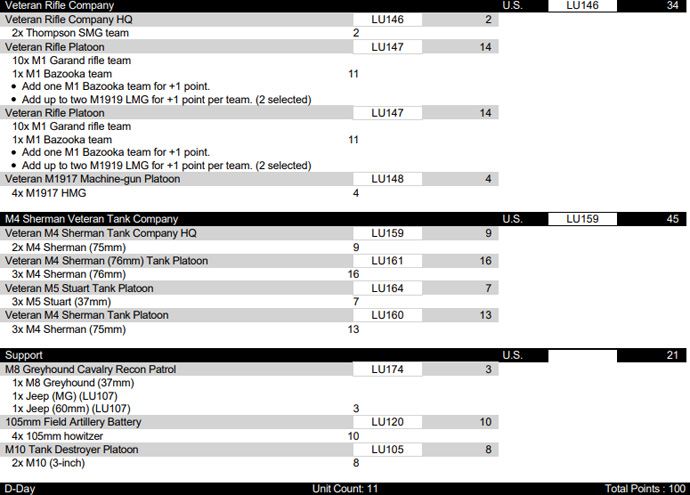 |
|
Double Formation, each of four units for the Formation breaks. The infantry will anchor the force and can defend the objectives or work with the tanks for attack. We have some AT12 for taking on enemy heavy tanks (from the flank), two artillery templates (yes - the 60mm mortar counts as one!). Recon to get your assault force into position for those missions that allow that. All Sherman’s and Stuarts have stabiliser meaning they can fire full ROF on the move with a +1 penalty to hit – but that is a lot of shots on the move. They are also bristling with machine guns, so deadly against infantry and gun teams – particularly if they are caught in the open!
|
|
To buy this army you need only to purchase the following for $170:
|
1 x USAB13 2nd Armored Division
|
160
|
|
1 x US805 M1917 Machine-gun Platoon
|
10
|
|
TOTAL
|
$170
|
|
|

|
|
2. M5 Stuart Veteran Tank Company
The second force to look at is again from the same book – The M5 Stuart Veteran Tank Company. Units comprising this Formation are:
- 1 Veteran M5 Stuart Tank Company HQ
- 2 Veteran M5 Stuart Tank Platoon
- 0-1 Veteran M5 Stuart Tank Platoon or Veteran M4 Sherman Tank Platoon
- 0-1 Veteran Armoured M4 81mm Mortar Platoon
- 0-1 Veteran M8 Scott Assault Gun Platoon or Veteran Sherman (105mm) Assault Gun Platoon
|
|
By purchasing two boxes of Stuarts on top of the army deal, we can create this list:
|
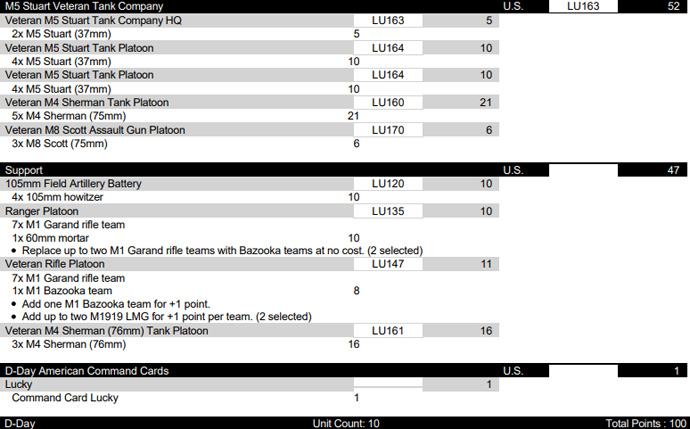 |
|
Five units for the Formation break. The light Stuarts are fast with stabiliser that can cause havoc when massed and backed by the Sherman’s. Three artillery templates now. Two infantry units – one of rifles supported by the 105s, that can defend an objective whilst the Ranger platoon should be used to assault (2+) with support from the tanks with all their MGs.
|
|
To buy this army you need only to purchase the following for $260:
|
1 x USAB13 2nd Armored Division
|
160
|
|
1 x UBX70 M5 Stuart Light Platoon
|
100
|
|
TOTAL
|
$260
|
|
 |
|
3. Veteran M4 Sherman (Late) Company
The next Formation we are going to look at is the Veteran M4 Sherman (Late) Company from the Bulge book. The units that comprise this Formation are:
- 1 Veteran M4 Sherman Tank (Late) Company HQ
- 1 Veteran M4 Sherman Tank (Late) Platoon or Veteran M26 Pershing Tank Platoon
- 1 Veteran M4 Sherman Tank (Late) Platoon or Veteran M5 Stuart Tank Platoon or M24 Chaffee Tank Platoon
- 0-1 Veteran M4 Sherman Tank (Late) Platoon
- 0-1 T26 Super Pershing Tank Platoon
- 0-1 Veteran Sherman (105mm) Assault Gun Platoon or M4 Sherman (Calliope) Tank Platoon
- 0-1 Veteran Armoured M4 81mm Mortar Platoon
|
|
By purchasing just one box of tanks in addition to the army deal, and using a couple of command cards, we can maximise our purchases:
|
|
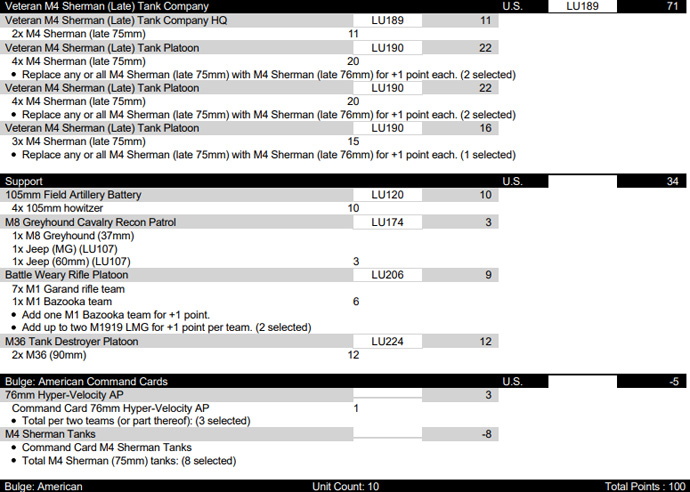
|
|
Four units for the Formation break. Using the M4 Sherman Tanks command card, we can substitute the M4 Sherman 75mm (late) with the M4 Sherman 75mm – which we have eight of. This gives us mixed platoons of 75mm and 76mm gun armed tanks. Use mistaken target to deflect hits from our 76mm tanks to the 75mm tanks. The 76mm Sherman’s are up gunned to AT13 with the HVAP command card. Two artillery templates now and just one infantry platoon. We still have the recon element to get our tanks into position when the mission allows. We have a small unit of M36 Tank Destroyers to provide that sniping AT14 at range.
|
|
To buy this army you need only to purchase the following for $210:
|
1 x USAB13 2nd Armored Division
|
160
|
|
1 x UBX88 M4 Sherman (Late) Tank Platoon
|
50
|
|
TOTAL
|
$210
|
|
|
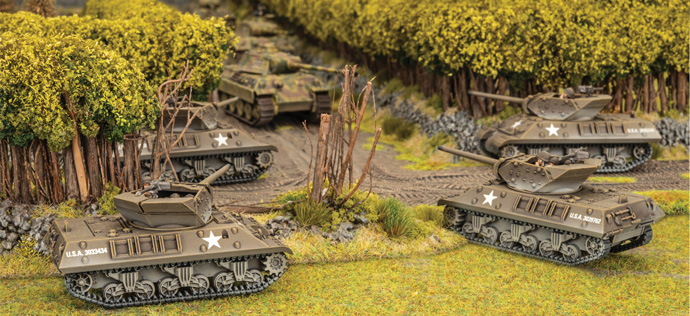
|
|
4. Glider Rifle Company
Finally, we round out article with the last Formation to examine – Glider Rifle Company. The units that make up this Formation are:
- 1 Glider Rifle Company HQ
- 2 Glider Rifle Platoon
- 0-1 Mortar Platoon
- 0-1 M1917 Machine-gun Platoon
- 0-1 Veteran 57mm Anti-tank Platoon
- 0-1 Glider 75mm Artillery Battery or 105mm Cannon Platoon
|
|
Again, we don’t need to spend too much more on top of the army deal. One box of guns and a couple of sprues:
|
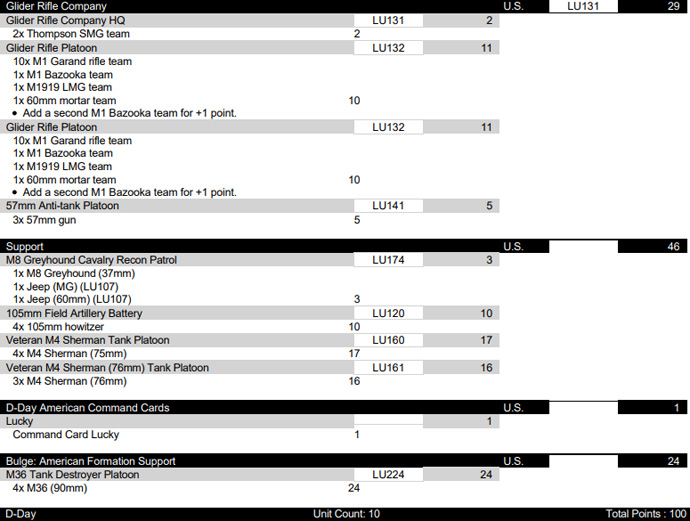 |
|
Four units for the Formation break. Two large infantry platoons supported by 57mm AT guns in the Formation. We still maximise our army deal with the recon, 105mm artillery, Sherman 75mm and 76mm supporting the Formation. Full M36 Tank Destroyer platoon to provide the heavy AT14 needed to clear out enemy armour.
|
|
To buy this army you need only to purchase the following for $210:
|
1 x USAB13 2nd Armored Division
|
160
|
|
1 x UBX81 57mm Anti-tank Platoon
|
30
|
|
2x USO201 Plastic M10/M36 Sprue
|
20
|
|
TOTAL
|
$210
|
|
|

|
|
There you have it – a few options to ponder for getting started with this army deal. Enjoy!
|
|
~ John
|